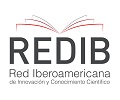




![]()
![]()
![]()


The structure must be as follows: pubication type (see above), title, author/s, affiliation, author for correspondence (include full address and e-mail), summary, key words, Resumen (abstract in Spanish), Palabras claves (key words in Spanish), introduction, materials and methods, results, discussion, acknowledgements (if there were any) and references. Supplementary material may also be provided (tables, figures, appendices), which must be cited in the text with its own numbering preceded by an "S", for example "Table S1".
Title: should be informative of the work presented, without being overtly long (max. 100 characters); It must be typed in bold, without final stop. When a taxonomic genus or species is included, do not add the authority, but do state order and family in parenthesis, for example: "(Diptera: Muscidae)".
Author/s: The format required is the last name (family name) and the initials (e.g. Leloir LF). Each name should be separated by colons. Affiliations should be indicated by superscript numbers.
Summary and Resumen: abtracts must be provided both in English and Spanish, each with a maximum of 200 words. The Resumen must begin by a Spanish version of the title.
Keywords and Palabras clave: after the Summary and the Resumen, provide a maximum of five key words for indexing purposes, in the respective language. They should be written in lowercase, and separated by a colon.
Nomenclature, units and abbreviations: Except for domestic animals, biotic organisms (vertebrates, insects, protozoans, plants, etc.) must be identified by their full scientific name when they first appear in the text (Genus species, authority year, e.g. Philornis downsi Dodge y Aitken, 1968), followed by Order and Family in parenthesis, e.g. “(Diptera: Muscidae)”. For chemical nomenclature use the conventions of the International Union of Pure and Applied Chemistry (www.iupac.org) and the IUPAC-IUB Combined Commission on Biochemical Nomenclature (www.jbc.org/content/241/3/527.full.pdf). For units and abbreviations, follow the international system of units (https://physics.nist.gov/cuu/pdf/sp811.pdf).
Abbreviations generated by the authors should be spelled out the first time used in the text, tables and figures. Sentences must not start with an abbreviation or a number.
Macro-molecules sequences: at the time of publication, if the work contains obtention of sequences of nucleotids or aminoacids, these should be deposited in GenBank or similar public repositories. The accession numbers should be included in the text, with no mention of them in the reference section.
Acknowledgements: add people or institutions that contributed with the research in any way that does not merit authorship. Add funding grant and instittutions, and conflict of interests and ethical considerations.
References: all references listed must be cited in the text. Cites in the text are done with the name/year system (last name of the first author, plus 'et al.' or co-author if appropriate, and year of publication). Two authors must be separated by a '&', and when there are three or more authors only the first author followed by 'et al.' should be used. When the same author has more than one referenced publication in the same year, letters are used after the year. Examples: 'Groeber 1946'; Angelelli & Fernández 1972'; 'Manzoli et al. 2013'; 'Legarreta et al. 1981b'. In the reference list (at the end of the manuscript), the cited articles are presented in alphabetic order (by last name of the first author) and chronologically (when one group of authors has many referenced contributions).
The format used for the reference list was taken from “Scientific Style and Format, 8th Edition, Chapter 29” (http://www.scientificstyleandformat.org), and are as follows:
Book:
Young M. 1992. Molecular genetics of biological rhythms. Ed. Marcel Dekker Inc., New York. 336 pp.
Book chapter:
Evans R. 1990. Therapeutics. In: Chandler E, Gaskell C, Hibalery A (eds.). Feline Medicine and Therapeutics. Ed. Acribia, Zaragoza. Pp. 431-447
Journal article:
Domenstein GM, Van Gogh H, Buitelaar MN. 1983. Clinical pharmacology and pharmacokinetics of flumekine after intravenous, intramuscular and oral administration in pigeons. J. Vet. Pharmacol. Therap. 6: 281-292. DOI: 10.1111/j.1365-2885.1983.tb00003.x
(Use standard abbreviations of each journal, with a stop after each abbreviated word).
Tables and figures: after the references, a separate page should be used for each table, and each figure, including their legends. If figures are sent separately, include a page with figure legends. All tables and figures must be referenced in the text (e.g. 'Table 3'; 'Figure 2').
Original articles must contribute with previously unpublished scientific results of research conducted by the authors. They are reviewed by peers in an anonymous external evaluation.
Short communications are also results of unpublished research, but that can be reported succinctly, although they must include enough detail of methods and results to enable full comprehension of the data. The inclusion of the titles and structure of original articles is optional.
Case reports are considered, if the contribution is of sufficient novelty and significance to Veterinary Sciences. They may include epidemiological surveillance reports, outbreak investigations, and other relevant events. As with short communications, they do not need to be structured as original articles.
Reviews must result from deep literature analysis, and should be contributed by scientists that have a demonstrated academic production in the subject matter.
Opinion articles are original personal perspectives on a specific scientific topic of interest for Veterinary Sciences. They may include infromative subtitles, tables, figures and boxes.
FAVE Sección Ciencias Veterinarias ratifies the open access model, in which contents (in full) are available free to anyone in the internet. The costs of production and publication are not transfered to the authors. This policy intends to break social and economical barriers that generate inequities in the access to information, and for the publication of research results.
All articles can be accessed at http://bibliotecavirtual.unl.edu.ar/publicaciones/index.php/FAVEveterinaria/issue/current/, under license Creative CommonsAtribución-NoComercial-Compartir Igual 4.0 Internacional.
Submissions will be treated as confidential, by the editorial board and by reviewers.





![]()
![]()
![]()


